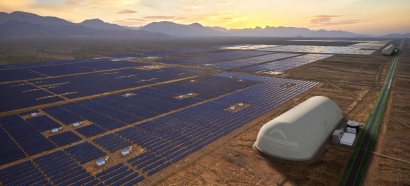
The CO2 Battery’s optimal charge/discharge cycle ranges from 4 to 24 hours, positioning it perfectly for daily and intra-day cycling, a fast-growing market segment that is not well served by existing battery technologies. Significantly, the CO2 Battery can be charged during daytime when there is surplus solar generation and dispatched during the subsequent evening and next-morning peaks, when solar generation falls short of demand. The modular, scalable energy storage solution will allow for solar and wind generation to be dispatchable 24 hours per day.
Using low-cost, off-the-shelf components in a patented, closed thermodynamic process, CO2 Battery achieves a 75-80% round-trip efficiency. And, unlike lithium-ion batteries that suffer significant performance degradation during their 7-10 year design life, the CO2 Battery maintains its performance during its expected 25 year operational life. Consequently, the cost of storing energy will be about half of the cost of storing with similar sized lithium-ion batteries.
The oversubscribed round was led by deep technology venture capital firm 360 Capital. 360 Capital is joined by other investors, including Barclays’ Sustainable Impact Capital program, a division of the banking giant Barclays which takes an impact investment approach, Geneva-based multi-family office Novum Capital Partners, and Third Derivative, a global climate technology start-up accelerator founded by RMI and New Energy Nexus.
Alongside the fundraise, Italian company A2A, a strategic investor via limited partnership with 360 Capital, has entered a Memorandum of Understanding with Energy Dome to deploy the company’s first commercial project. This proposed 100 megawatt-hour (MWh) CO2 Battery could support the increased use of renewable power in the generation mix and address the growing need for energy storage on electrical grids.
Energy Dome has achieved this paradigm shift in the cost of storage by using CO2 in a closed loop cycle where it changes from gas, to liquid and back to gas. The titular “dome” is an inflatable atmospheric gas holder filled with CO2 in its gaseous form. When charging, the system draws electrical power from the electric grid, which feeds a motor. The motor drives a compressor which draws CO2 from the dome and compresses it, generating heat which is stored in a thermal energy storage device.
The CO2 is then liquified under pressure and stored in liquid CO2 vessels, at ambient temperature, to complete the charging cycle. When discharging, the cycle is reversed by evaporating the liquid CO2, recovering the heat from the thermal energy storage system, and expanding the hot CO2 into a turbine, which drives a generator. Electricity is returned to the grid and the CO2 re-inflates the dome without emissions to the atmosphere, ready for the next charging cycle. The system components are standardised and modular, allowing for up to 200 MWh in storage capacity, and targeting a wide range of customers including utilities, independent power producers, grid operators, industrial applications and remote mining Operations.
The company was founded and is led by serial energy entrepreneur Claudio Spadacini. In less than two years, Energy Dome’s team of engineers turned an engineering concept into reality with patents filed and a 2.5MW x 4MWh demonstration plant now under construction in Sardinia and expected to be tested and validated in the first quarter of 2022.
“Grid systems across the world need effective, low-cost storage to pair with renewable energy,” said Claudio Spadacini, founder and CEO of Energy Dome. “We’re excited to be leveraging this investment and agreement to accelerate our deployment of this transformational technology. We thank all of the supporters who made today’s announcement possible.”
"Long-term energy storage will play a pivotal role in tackling climate change, paving the way for a carbon-free grid,” said Cesare Maifredi, managing partner of 360 Capital. “Energy Dome's technology is an innovative yet ready-to-market solution which makes long-term energy storage a reality today. It materially contributes to the energy transition, while delivering substantial value to its clients, grid operators and ultimately to our society."
“Energy Dome’s ground breaking technology addresses the issue that transitioning to a low carbon economy requires not only renewable energy sources, but effective ways of storing this energy, to help balance supply with demand,” said Steven Poulter, Head of Principal Structuring and Investments at Barclays. “Barclays is pleased to be supporting Energy Dome’s next stage of growth, as they continue to drive efforts to reduce carbon emissions worldwide."

